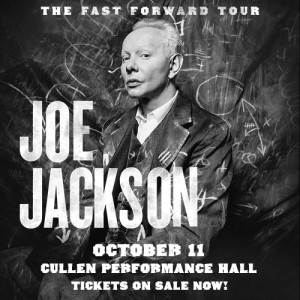FPH Interview: Roger Deakins

A quick look at cinematographer Roger Deakins’ website shows his accomplishments, which include membership in the ASC (American Society of Cinematographers) and the BSC (British Society of Cinematographers). But Deakins is also CBE, or Commander of the Most Excellent Order of the British Empire.
“You get a phone call out of the blue,” says Deakins in a phone interview with Free Press Houston. Deakins notes that it was Princess Anne who bestowed him the honor rather than the Queen.
Deakins’ current film, Sicario, teams him with director Denis Villeneuve. The two previously worked together on Prisoners, and will work again on the upcoming sequel to Blade Runner (with Harrison Ford and Ryan Gosling).
“It gets easier once you know somebody,” says Deakins about working with Villeneuve. “We compliment each other quite well, it’s chemistry. You get on with some people better than you get on with others. We’ve certainly had a similar take on the two films and we share similar ideas. We have a similar take with what we want to do with Blade Runner.”
Regarding the sequel to the landmark sci-fi film Deakins mentions the way the light comes in through windows and lots of smoke. “Blade Runner has a wonderful particular look, it’s kind of a modern film noir really. The fact it’s a noirish film will probably stay but whether the lighting is anything similar I don’t know. I’m not Jordan Cronenweth so it’s going to look different. It’s too early in the process so I’m not going to say anyway. You have to see it,” says Deakins.
Audiences that have seen Prisoners know it has one of the single best endings of any film ever made. Late in the film the character played by Jake Gyllenhaal speeds down the road on his way to the hospital. Deakins recalls how it was shot over two nights with additional processed shots on a stage.
“We were at two locations so the second night was in front of the hospital. We did a split, half of the night we were outside the hospital and then we had a full night, which was the last night of shooting in fact, doing the actual driving down the lane, down the unlit road and then through the lit first street.
“There was quite a lot of set-up time because there were a number of cars we had to have on the street. And then we did a wet-down, that takes time. We were going at quite a pace, so it was kind of dangerous. There was quite a number of stunt drivers. You rehearse something at slow speed so everybody knew where they were going to be,” says Deakins. “Then you gradually increase the speed before you do a take, yeah.”
In Sicario there are a number of scenes that involve character point-of-view mixed with action set-ups. “That whole sequence where they go to Mexico to pick up the guy from jail and then come back and get ambushed on the border,” says Deakins. “Logistically that was the most difficult scene to do because how do you do it? You can’t shoot it at a real border crossing. We scouted the Bridge of Americas between El Paso and Juarez, which is the bridge it’s meant to be. But we couldn’t actually shoot there. We did the helicopter shot over the bridge and then the SUVs are digitally put into that shot.
“I mean you can’t block the road at the border. And if we did imagine trying to get take two,” says Deakins.
“Then we doubled Mexico City for Juarez, because we couldn’t shoot in Juarez. We couldn’t get the insurance to take the actors there. When they cone back through the border, we built that set on a parking lot in Albuquerque. We had 150 cars, and everything was mapped out, planned and storyboarded. Every day we had a list of shots we would do. That was three days, which sounds like a lot of time but it’s actually not when you have so many extras, and so much action, yeah,” says Deakins.
Another sequence, the tunnel scene, which takes place at night utilizes thermal photography and night vision. “The entrance to the tunnel was on location but the interior was built in a studio, yeah,” says Deakins. “We mapped out the action. Patrice [Patrice Vermette] the production designer had made the tunnel to accommodate the action Denis wanted. He also made in practical enough so we could shoot in it. The opening shot going into the tunnel is Alejandro’s [Benicio Del Toro] point of view, because he has the thermal imaging system. So you follow in the footprints and you see the dead bodies at the bottom of the stairs. All that had to be constructed so that the steadicam operator could walk down the stairs and make the turn, and create that shot. Yeah, it had to be well planned out.”

“The scene you’re talking about, we had discussed that prior to shooting. We storyboarded the action we wanted and the shots we were going to do. We didn’t have a lot of time to shoot that, and it’s done in cuts so it’s not like dialogue scenes where you need to rehearse with the actors beforehand. So there are very specific shots that build up the sequence,” explains Deakins.
Sicario, which opens this weekend, stars Emily Blunt as an Arizona police officer that specializes in drug cartels and border patrols. Blunt is recruited by government agents Josh Brolin and Del Toro. As the movie progresses it becomes apparent that Brolin and Del Toro have other motives than mere law enforcement. There’s also a bit of ambiguity as to which agency they actually belong. Sicario, which means hitman, keeps ratcheting up its action and excitement all the way to its startling ending.
Deakins has also worked extensively with directors like Sam Mendes and the Coen Brothers. Talking about filming in cold conditions for Fargo, Deakins says: That was shot using a film camera “so back then you had to be very careful that the oil used in the camera is a lighter oil than normal. And you have a lot of heating barneys that you can wrap the camera in.
“Shooting in adverse weather can be difficult. The funniest thing if you want to talk about cold in Fargo wasn’t the camera. The key grip Mitch Lillian [who also worked on Sicario], he got this wonderful thermal suit, and he was almost toast inside of it. But he couldn’t move. He was warm but he couldn’t work,” laughs Deakins.
— Michael Bergeron
















